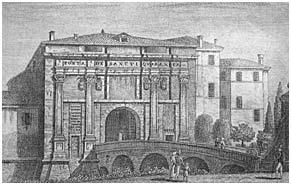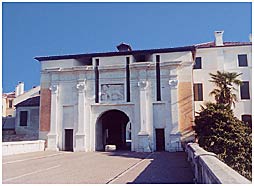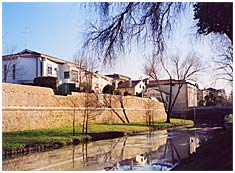| PORTA SANTI QUARANTA - Treviso |
| |
| The present location of Porta Santi Quaranta (Forty Saints Gate) is farer
from the Treviso centre (100 metres) than where the Gate was long ago, when the medieval Walls, developing a
narrower perimeter, defended the quarters of town. |
| |
|

Porta Santi Quaranta - 1846
Engraving by Antonio Nani
(Biblioteca Comunale di Treviso) |
  |
Porta Santi Quaranta is contemporary with Porta San Tomaso (Gate of St. Thomas)
according to the history; they both allowed (and they allow also today) travellers coming from West (from Padua,
Montagnana, Vicenza, Castelfranco Veneto) to enter Treviso. Porta Santi Quaranta (Gate of Forty Saints) have
a facade in Istrian stone from the outside and a middle wider arch and sideways two smaller arches.
The most significant picture on the outside fašade is the portrait of winged lion, which is the emblem
of the Venice power on the near and far lands. |
| |
|
| The Istrian stone slab, showing the winged lion,
was destroyed during the French occupation in the end of 18th century and then it was rebuilt again as the
old slab was. |
| |
|
Porta Santi Quaranta (Gate of Forty Saints) has a square plan ant it
raises with one order of four pilasters supporting the sturdy trabeation under the Istrian stone cornice,
while the inside fašade is simply plastered except three squares of three arches. The middle arch was
decorated by a pictorial reproduction of St. Mark lion (Venice emblem), this picture is illegible now
because of the inclemency of the weather. The roof is made by wooden trusses with a tile covering.
The Venice winged lion is located over the middle main arch likewise the other Gates. |
 |

Porta Santi Quaranta today |
|
| |
The facades of Porta Santi Quaranta and of Porta San Tomaso (Gate of St. Thomas) are ornamented by
some heraldic devices besides by the Venice Lion. The indoor space is characterized by three cross vaults
supporting a floor which allows to use a garret room.
Porta San Tomaso (Gate of St. Thomas) had some
drawbridges: the one used by wagons, the other used by pedestrians in its history, they both were ready
to be raised if an enemy had attacked the town. |
| |
|

The Treviso Walls near
Porta Santi Quaranta |
 |
The drawbridge was replaced by a bridge made by bricks
and decorated with pillars and borders by Istrian stone in the course of time and because the dangers had ceased. We may
read the inscription bearing the name of the Monument over the middle main arch of Porta Santi
Quaranta (Gate of St. Quaranta): it is written in Latin to those who are going out: "Porta Sanctorum
Quadraginta" and in dialect of Veneto to those who are entering: "Porta Sancti Quaranta", the two
different inscriptions had to emphasize the difference between the aristocratic centre and the
country out the Walls. |
|
| |
|
The dedication to "Santi Quaranta" (Forty Saints) is inspired by this fact:
forty soldiers were besieged and burnt because they refused to recognize the idol during the
Licinio’s persecution in Armenia.
This fact is a mark of faith and of last sacrifice to those who
entered the town from this gate.
The name of Porta Santi Quaranta (Forty Saints Gate) changed
also into "Porta Cavour" in the Risorgimento period for some decades and after it got back its name. |
| |
| |
| |
|
| |


